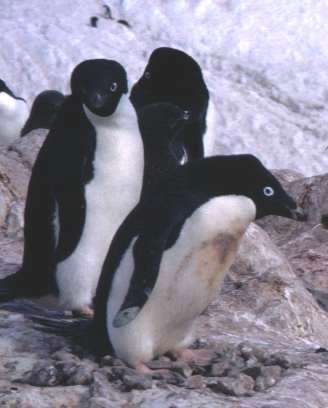


|
|
| |||



| ||||

|
|
Adelie PenguinPygoscelis adeliaeBreeding Range: Antarctica, South Shetlands, South Orkneys, Bouvet, Balleny and Peter Island Length: 70cm. World Population: 2,500,000 breeding pairs Among the 17 species of penguins, Adélie penguins Pygoscelis adeliae are the best studied of all penguins. They were named from Adélie Land, where they were first scientifically described in 1840 by the French explorer Jules Dumont d’Urville, who named this portion of the Antarctic continent in honor of his wife, Adèle. Compared to other penguins, the Adélie penguin’s simple black and white robe lacks the exotic touch of the Macaroni’s and Rockhopper’s hairs or the colourful throat patch of King and Emperor penguins. However this simple plumage ensures good camouflage against predators and prey - black back against the dark depths of the sea, and white belly against the bright sea surface above. While sexes are alike, males are slightly larger than females, especially their bill. Bill length is often used to determine sex. Adélie penguins weigh between 3.8kg and 5.8kg depending on their stage in the breeding season. A total of 2.5 millions pairs of Adélie penguins currently breed on the Antarctic continent and the small islands around it, the largest concentration being encountered in the Ross Sea region (1,000,000 pairs).
The annual cycle can be summarized by the following milestones: These stages in the breeding cycle are highly synchronized to the Antarctic summer (October to April) to take advantage of the light sea ice and the peak in marine resources that occur at that time. The reminder of the year is spent at sea where birds show little signs of activity. Adélie penguins lay one or two eggs, each weighing 100g to125g (about 2.6% the female body mass). The eggs are incubated alternatively by each parent for a period of 30- 40 days. This short incubation period (in comparison with that of Gentoo or Chinstrap penguins) is due to the short Antarctic summer. Newly-hatched chicks are incubated by one parent while the other feeds at sea, with changes in incubation duties taking place every 1 to 3 days. This guard phase lasts 22 days and is followed by a crèche phase during which both parents forage at sea, and unattended chicks gather in small groups of 3 to 20 chicks, called crèches. This reduces the risk of predation and helps to protect the chicks from severe weather. Fledging occurs after 52 to 61 days, with an average of 77% of chicks surviving to fledge. Studies conducted in several locations have revealed that populations of Adélie penguins are either stable or increasing, but since population trends are highly dependent on the sea-ice distribution, there is a fear that global warming may ultimately affect Adélie penguin populations. Adélie penguins colonize the ice-free zone of the Antarctic continent for the short summer breeding season, and their at-sea activities (90% of their life) depend on the structure and annual fluctuations of the sea ice to a point that they are sometimes referred to as the creatures of the pack ice (sensu Ainley). This intricate relationship is illustrated by the birds’ foraging ranges, which are defined by the maximum extent of the sea ice. When at sea, Adélie penguins lose their sluggish appearance, common to all penguins on land, to become torpedo-like swimmers that hunt their prey at depths of up to 170m, during dives that can last over 5 minutes. However, most of their diving activity is concentrated in the first 50m of the water column, because being visual predators, their maximum dive depth is determined by light penetration. These extraordinary diving performances are permitted by a series of physiological and biochemical adaptations that allow Adélie penguins to extend their time beyond that which other penguins of similar size cannot withstand. Adélie penguins feed principally on a mixed diet of Antarctic krill Euphausia superba and Crystal krill E. crystallorophias, although the diet switches progressively to fish (mostly Pleuragramma antarcticum) during the breeding season, and squid during winter. When diving from the water surface to the depth at which they find their prey, Adélie penguins adopt a cruising speed of 2m/s, which has been thought to represent the speed that gives the minimum energy cost. However, once they reach the dense schools of krill at the bottom of their dives, they slow down in order to catch their prey. They generally prefer female krill heavy with eggs, which have a higher energy content. Today the threats of global environmental change, and competition from commercial fishing, threaten the future of seabirds and Adélie penguins, which rely on sea-ice and krill. Adélie penguins also face predation by Leopard seals and killer whales at sea, and Giant petrels and skuas on land. Recommended lecture: The Adélie penguin: bellwether of climate change. By D. G. Ainley. Columbia University Press, New York, 310 p. Web Page written by Yan Ropert-Coudert |